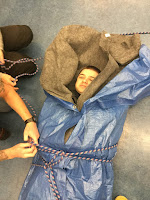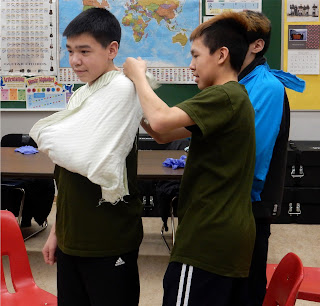February
15, 2017. The day had finally arrived.
I was
feeling excited but also nervous. I was entering
a new phase in my career as a CIC officer.
(CIC
stands for Cadet Instructor Cadre and is a branch of the Canadian Armed Forces
Reserves. The primary duty of CIC
officers is “the safety, supervision, administration, and training of Royal
Canadian Sea, Army, and Air Cadets.”)
I
joined the CIC in 2013, being officially sworn in as an officer cadet on
November 11, in Arctic Bay. The first
cadet corps I worked for as a CIC officer is 3045 Army, Canada’s most northern
cadet corps. I worked in the capacities
of second-in-command (2IC) and training officer. I took courses online and completed basic
officer training to obtain the necessary qualifications to be promoted to the
rank of Second Lieutenant (2Lt). But I
was also being prepared, by the commanding officer (CO), Lt. May, to take
command of the corps because he was nearing retirement.
In
the months leading up to February 15, Lt. May taught me the ins & outs of
running a cadet corps. I always
saw myself being in charge of a cadet corps, but at the rank of 2Lt.? Never.
I was thinking much further in the future, because COs are usually
Captains or Majors. But, I was reassured
by May & our superiors in Winnipeg, that there are cases where corps
located in remote areas need to rely on what is available to them. So, I guess, I was the officer to see 3045 stay
afloat. Canada has already lost quite a
few cadet corps north of the 60th parallel, mostly due to there not
being adults willing to take “the reins.”
I was and still am immensely grateful for the guidance and support of
Lt. May & the Regional Cadet Support Unit (RCSU) in Winnipeg.
A
Change of Command Parade was organized and the RCSU in Winnipeg sent Cpt.
Aastrom with the proper documentation and to overseer the proceedings. I met him last year during the Silver Star Training Expedition. Lt. May &
I picked him up at the airport and drove him to the former bed & breakfast
building. The bed & breakfast is
used by the local Tangmaarvik Inn when its building is full. Surprisingly, this was my first time inside
the bed & breakfast and the interior is big. The building is a mini-mansion with about six bedrooms. We had a meeting with Cpt.
Aastom the night before the parade to get all the necessary affairs in order so
that the transition would go smoothly.
Unknown
to Lt. May, the staff of 3045 and community members had planned a proper send
off for his many years of service in the CIC & in the community. Pictures, letters, videos, and gifts were
collected from various sources. We would
also be celebrating his birthday. We all
remained tight-lipped on what was to come.
 |
| Free photos after the parade! |
The
cadets prepared for the parade by reviewing the necessary drill movements,
cleaning & ironing their uniforms, and polishing their parade boots. The cadet platoon commander reviewed the
drill commands and led the cadets through several rehearsals. I also made sure my dress uniform was ready
for the big occasion.
On
the evening of February 15th, Inuujaq School’s gym was transformed
into a parade square. Chairs, tables,
flags, sponsor banners, and photographs were set up along the gym walls. I personally set up a projector in one of the
corners, displaying past pictures of Lt. May working at the cadet corps. People began to arrive a little after 6:15pm
and by 6:30, there was a large audience.
 |
| Inspection. |
 |
| March Past. |
The
parade began with the officers, Cpt. Aastrom, Lt. May, and I, marching into the
gym. Aastrom was the guest reviewing
officer for the parade. He, I, and
Ranger Ejangiaq inspected the cadets on parade. Clare Kines was hired by the corps to take
pictures. The cadets did a March Past
after the inspections.
 |
| Cadets on Parade. |
 |
| Captain Aastrom presents a t-shirt to a Fall Biathlon winner. |
Cpt.
Aastrom was given the floor to say a few words.
He introduced himself and stated that this was his first time travelling
to Nunavut. He thanked the cadets &
audience for coming to the first official change of command parade in the corps’s
25-year history. He also encouraged
members of the community to consider volunteering at the cadet corps and/or
enlist in the CIC.
 |
| Biathlon Team. |
The
parade moved on to the Awards section.
First, the Fall Biathlon winners were called to the front to receive their prizes. (The corps held a biathlon competition last October). Captain Aastrom presented t-shirts & army styled wallets to the lucky cadets. Next, the Biathlon Team was called to the front to be acknowledged for their
participation in the territorial competition that was held in Whitehorse in
January. The corps also acknowledged
cadet Tilley, Dylan for being selected to participate in the upcoming National
Biathlon Competition in Valcartier, Quebec at the end of February. He is the first cadet from Arctic Bay to be
selected for the national competition.
 |
| Lt May speaking about the Marksmanship Team. |
 |
| Captain Aastrom handing a PT badge to a cadet. |
Next
came the awarding of marksmanship badges.
There are four levels to attain in the cadet program. Level 1 is the lowest and Level 4 is the highest. Civilian Instructor Reid presented the
badges. Lt. May called out the newly
created Marksmanship Team to be acknowledged by the audience and to let
everyone know that they would be getting ready for a marksmanship competition
in two months. I concluded the Awards
section of the parade by handing out physical fitness (PT) badges. PT tests are held once every month and
depending on their results, cadets can earn Bronze, Silver, Gold, or Excellence
badges.
 |
| Me speaking to the audience. |
 |
| Me signing the Change of Command Certificate. |
The
moment was finally here. Captain Aastrom
produced three Change of Command Certificates that needed to be signed. I held my breath and took out a pen. Clare Kines took pictures of the three
officers signing the documents. I didn’t
exhale until Aastrom lifted one of the certificates in the air and said, “Now
it’s official.” An applause
followed. I was now the commanding officer
(CO) of 3045 Army Cadet Corps, Canada’s most northern cadet corps.
 |
| "Now it's official." |
 |
| Lt. May has one last group photo with the cadets. |
The
last part of the parade was devoted to saying thank you to Lt. May for his many
years of service, and to wish him a safe & happy retirement. I read a prepared letter from an officer in
Iqaluit who worked with Lt. May on many occasions. Next, we played two videos addressed to Lt.
May. The first video was from his
daughter, playing the guitar and singing Happy Birthday to him. The second video was from 3019 Army Cadet Corps
in Rankin Inlet, wishing the former CO a well retirement & Happy Birthday.
 |
| I. Swoboda leads everyone in a standing ovation for Lt. May. |
The
local social worker, I. Swoboda, took over and gave a short speech about her
many years of knowing & working with Lt. May. She then presented two gifts: professionally
done portraits of him. She then
concluded her presentation by leading everyone in a standing ovation.
 |
| My first salute as the new CO of 3045. |
The
cadets were applauded by the audience at the end of parade. Everyone headed over to the reception table
for snacks. I quickly took a photo of
the large cake that was specially made for the occasion. People personally thanked Lt. May for his
time as CO, and congratulated me for being chosen to take over. I also personally thanked Lt. May for his
time as CO and for helping me prepare for the top job. Deep down, I knew a lot of hard work and
responsibilities were ahead of me. But
now was a time to celebrate.
A new
chapter in the corps’s history begins.
 |
| Thank you Lt. May for your hard work & devotion to 3045 Army Cadet Corps. |




























